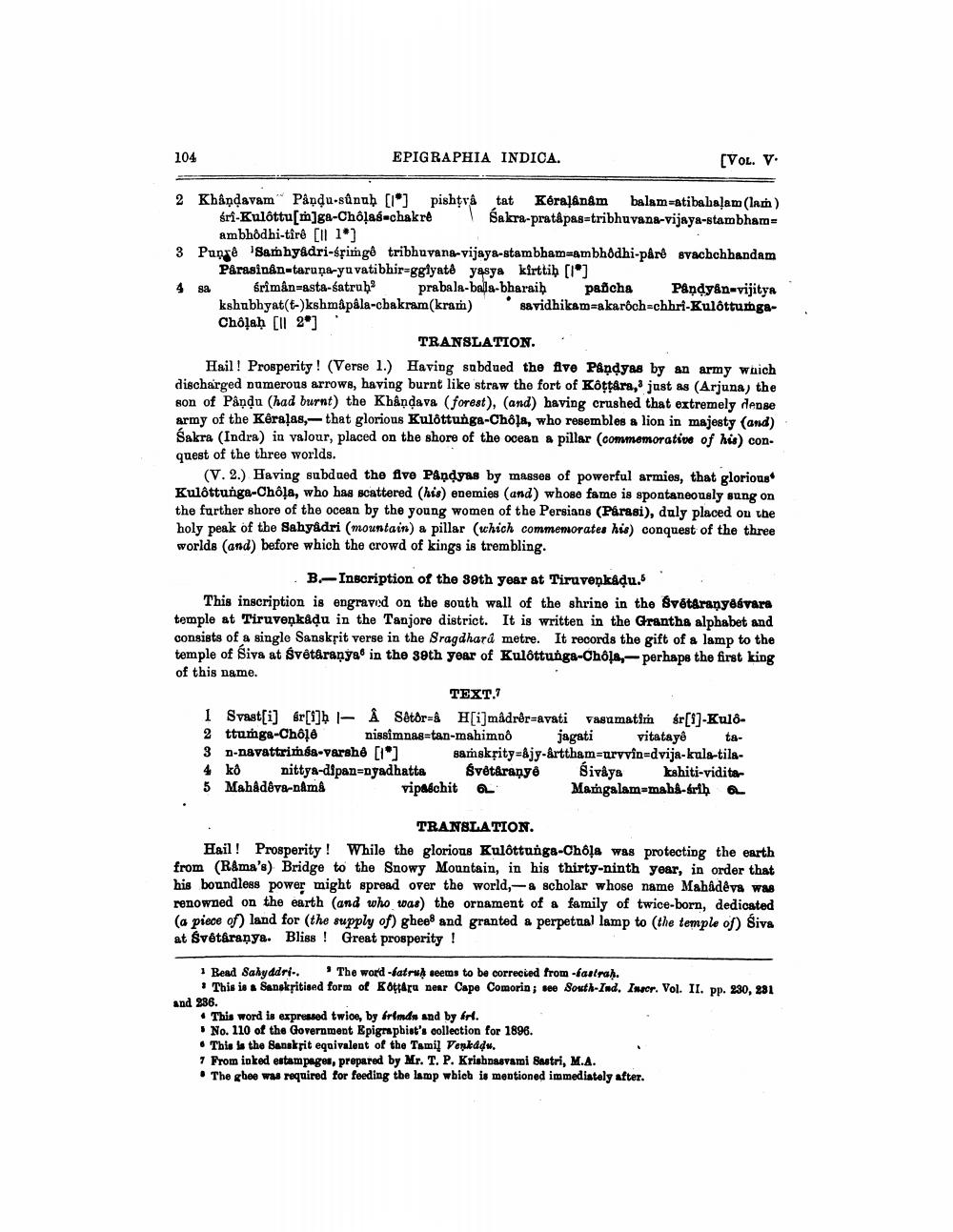________________
104
EPIGRAPHIA INDICA.
(VOL. V.
2 Khandavam Pandu-sûnuh [1] pishţra tat KéralAnam balam=atibabalam(lar)
sri-Kulôttu[m]ga-Chôļas-chakre Sakra-pratapas-tribhuvana-vijaya-stambham
ambhodhi-tîrê [ll 1) 3 Punge Samhyadri-spimg8 tribhuvana-vijaya-stambhamwambhôdhi-páré svachchhandam
Parasinân-taruņa-yuvatibhir=gglyatê yasya kirttih [1] 4 sa śrîmån=asta-satruh prabala-bala-bharaih pañcha Pandyan-vijitya
kshubhyat(t-)kshmåpala-chakram(kram) savidhikamaakarôch=chhri-KulôttumgaCholah [ll 2]
TRANSLATION. Hail! Prosperity! (Verse 1.) Having subdued the five Pandyas by an army which discharged numerous arrows, having burnt like straw the fort of Kottara, just as (Arjuna) the son of Påndu (had burnt) the Khåndava (forest), (and) having crushed that extremely dense army of the Keralas,-that glorious Kulottunga-Chola, who resembles a lion in majesty (and) Sakra (Indra) in valour, placed on the shore of the ocean a pillar (commemorative of his conquest of the three worlds.
(V. 2.) Having subdued the five Pandyas by masses of powerful armies, that glorious Kulôttunga-Chola, who has scattered (his) enemies (and) whose fame is spontaneously sung on the further shore of the ocean by the young women of the Persians (Parasi), daly placed on the holy peak of the Sahyadri (mountain) a pillar (which commemorates his) conquest of the three worlds (and) before which the crowd of kings is trembling.
B.- Inscription of the Seth year at Tiruveņkaļu. . This inscription is engraved on the south wall of the shrine in the Svetaranyósvara temple at Tiruvenkadu in the Tanjore district. It is written in the Granthe alphabet and consists of a single Sanskrit verse in the Sragdhará metre. It records the gift of a lamp to the temple of Siva at Svetaranya in the seth year of Kulottunga-Chốls, perhaps the first king of this name.
TEXT. 1 Svast[i] ér[i]h - Å Sêtör=& H[i]madrêr-avati vasamatin śr[i]-Kulo2 ttumga-Chôļe nissimnas-tan-mahimnô jagati vitatayê ta3 D-navattrimśa-varshe [1] Samskrity=&jy-&rttham-arvvin-dvija-kula-tila4 kồ nittya-dipan=nyadhatta Svêtåranye Sivaya k shiti-vidite 5 Mahadeva-nama
vipaéchit 6L
Mangalam=maba-srih
TRANSLATION. Hail! Prosperity! While the glorious Kulôttunga-Chols was protecting the earth from (R&ma's) Bridge to the Snowy Mountain, in his thirty-ninth year, in order that his boundless power might spread over the world,-a scholar whose name Mahadeva was renowned on the earth (and who toas) the ornament of a family of twice-born, dedicated (a piece of land for the supply of) ghee and granted a perpetual lamp to the temple of Siva at Svetaranya. Bliss! Great prosperity !
* Read Sahyadri.. The word -fatru seems to be correcued from faulrah.
This is Sanskritised form of kotaru near Cape Comorin; see South-Ind. Inscr. Vol. II. pp. 230, 231 and 286.
• This word is expressed twice, by frnds and by fri.
No. 110 of the Government Epigraphist's collection for 1896. • Tbia sa the Sanskrit equivalent of the Tamil Venkadu. 1 Prom inked estampages, prepared by Mr. T. P. Krishnasvami Bastri, M.A. • The gbee was required for feeding the lamp wbieb is mentioned immediately after.




